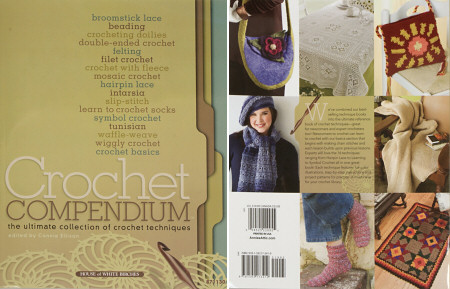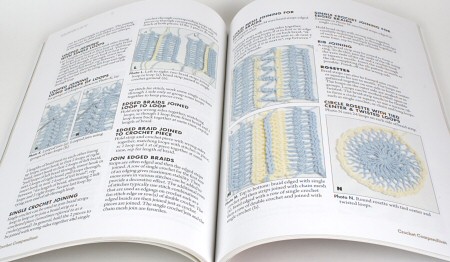Let’s get this out of the way first: I was given a copy of this book to review. But I’m not being compensated for this review in any other way, and the following is based on my honest opinions!
Overview
Annie’s Attic say, about their new book Crochet Compendium: The Ultimate Collection of Crochet Techniques:
We’ve combined our best-selling technique books into the ultimate reference book of crochet techniques – great for newcomers and expert crocheters too!

Crochet Compendium front and back covers
While I’m not sure that this is the ultimate reference book (it’s hard to imagine any book that could cover every crochet technique, and especially one with less than 140 pages!), what this book does include is a collection of a variety of lesser-known crochet techniques, some of which, I was happy to see, were brand new to me.
Each technique is covered with between 1 and 10 pages of illustrated instructions, followed by one or two projects using the technique. In all, this book includes 16 techniques (plus the ubiquitous crochet basics) and 20 projects. It provides an overview of many crochet techniques that you may not be familiar with, including:
- beaded crochet
- broomstick lace
- doilies
- double-ended crochet
- felting, filet crochet
- crocheting with fleece
- mosaic crochet
- hairpin lace
- intarsia
- slip-stitch crochet
- crocheting socks
- symbol crochet
- Tunisian crochet
- waffle-weave
- wiggly crochet
Annie’s Attic previously published each of these techniques as separate booklets, and in this book you get all the instructions from those booklets (but fewer patterns for each than if you bought the individual booklets), so it’s a very good deal if you’re interested in learning new techniques – you get a lot of value for money here.

Part of the extensive hairpin lace instructions
Tucked away at the very end of the book, there’s a 31-page section on crochet basics, which seems like a strange place to hide it, as it’s not referenced anywhere else in the book. Most of this is the general “how to sc”, “how to dc” etc, but the final few pages include tables of standard abbreviations, metric conversions and international hook size conversions (and knitting needles too – oops!), skill levels, and yarn weights – this is actually useful reference information to keep handy, as now I won’t need to keep looking it up at yarnstandards.com! The final page is a one-page stitch guide covering abbreviations (again), international stitch conversions, and basic stitch instructions (again), but it’s in a nice single-page format.
The various techniques require and provide differing amounts of well-illustrated instruction before jumping into the project(s): crochet with fleece, for example, needs no more than a page on how to cut and join fleece strips to make your ‘yarn’, while hairpin lace includes 10 pages of braid variations and methods for joining them together.
My Experience
For my review, I thought I’d trying jumping in as a beginner to see how I’d cope with a totally new (to me) technique: Mosaic Crochet. I started out like a good little student, by reading the 4 pages of provided instructions. It seems very thorough, but I wasn’t at all clear what the fabric would look like: there are no photos of the wrong side of the fabric in either the technique or project instructions. I assumed (as the provided project is a scarf) that this technique produces a double-sided fabric – it would be strange to have a scarf that you have to keep flipping over to make sure that only the ‘right’ side shows! – but I thought from what I’d read that there would be strands of chains visible on the back of the project… What would that look like? Why hasn’t the book shown me, so I can tell if I’m doing it right..?!
Clearly, I was overthinking: time to jump in and start the project so I could see how it really works! I decided to make a swatch sized such that I could turn it into a slip case for my lifeline (aka my BlackBerry). I chose two blackberry-ish shades of Patons Grace and a C hook. I followed the ‘charts with repeats’ sample on p50-51, using 2 repeats instead of 3 to fit the width of my BlackBerry.

The pattern I followed for my sample
Mosaic crochet is not a simple technique to learn. The chart looks very easy to follow, but each square represents two rows, not one, and you have to either sc, dc, or chain into/over each stitch, depending on both the colour of the stitch and the colour of the stitch in the row below – so there’s a lot to get your head around. Luckily, the sample includes both the chart and row by row written instructions, so you can check you’ve understood the ‘rules’ when interpreting the chart.
By Row 5, I was starting to think I’d got the hang of it, but then the written instructions disagreed with what I understood from the chart. I followed my instincts and went with my interpretation of the chart, and it turns out that the written instructions were wrong (it said “sc in each of next 6 sts” instead of “dc, sc in next 4 st, dc”). After that, I figured I had the technique down and followed the chart up to the top (Row 14), ignoring the text. Luckily I checked the text again as I finished my first repeat – it turns out that none of the included charts include any rows that are all one solid colour (Rows 15-16 in this case), so you do have to follow the written pattern instructions as well as the chart.

Finished sample (right side)
I had the technique and the stitch pattern figured out by this point, and so I could complete the case without any more problems. (To make my sample rectangle into a case, I just folded the top down by a small amount and the bottom up to meet it, and then single crocheted the front and back together along each side.)

My BlackBerry case
I’m really happy to have learnt the technique (although I do feel that I could have explained it more clearly than these instructions did). The result looks really cool, don’t you think? I love the patterning. And FYI, the reverse side looks like this (below): not the same as the front, but the chains look like slight wavy bumps against the stripes, so it forms its own interesting pattern.

Mosaic crochet (wrong side)
Peeves
In my cursory glance through the book, I did spot a couple of other errors (e.g. the double-ended crochet instructions had two photos showing the first vertical bar, where one should have shown the first horizontal bar). This was surprising as the book is excerpted from other, previously-published books, so I’d have thought the instructions would have gone through 2 technical editing processes and be super-accurate as a result. [If any publishers are reading this, I’m a qualified and thorough technical editor and an experienced crocheter and I’d love to improve your crochet books for you!]
This book feels disjointed – it is a compilation, and that’s very obvious: the style is varied throughout (colour or black and white photography and/or dimensional or flat illustrations), and no chapter references any other. In some cases one chapter even contradicts another, e.g. US slip stitch is given as equivalent to UK slip stitch (p86) and to UK single crochet (p134). In practice, though, you probably wouldn’t even notice these inconsistencies, as you’d only be working with one technique/chapter at a time. The wealth of information included here definitely makes up for the lack of cohesion.
Final Thoughts
If you view Crochet Compendium as a collection of booklets in one convenient binding, you won’t be disappointed. I really enjoyed browsing the variety of lesser-known techniques that are included, and I’ll definitely return to this book in future; I can tell that it’s going to be a useful title to add to my reference collection.
For non-crocheters, I wouldn’t recommend this as your learn-to-crochet book, as the crochet basics section is instruction only: there are no basic projects to practice on. But if you’ve conquered amigurumi and granny squares and are wondering where to go from here, Crochet Compendium: The Ultimate Collection of Crochet Techniques would be a great book to whet your appetite for some very interesting crochet techniques – I’m sure you’ll find something that’s new to you inside!
















Sara said
Thank you so much for the review. I purchased an eBook of the few pages with instructions for mosaic crochet. I came to almost the same spot in the pattern above (row 5) and it said 6sc across next 6sts. It shoud have said 2sc, 2dc (into 3rd row below), 2sc across next 6sts. I agree that this should have been caught in the editing/proof-reading process of the larger book. I started following the chart, which is pretty easy once you understand the method, and it’s going pretty good. All in all I really like this technique. Thanks again for the review.
By the way, I’m working on the super-sized turtle pillow for my husband. I really like the pattern.
Cori Berg said
They need to send you the book to look for errors before it goes to print!
robynlicious said
I really appreciate your thorough review. I so rarely see a review that includes negative aspects of the book. It might be helpful to contact them with the problems you encountered so that they can start an errata.
June said
In my opinion, this is the only kind of review anyone should write! A review that omits any negatives is nothing more than an advert, and I wouldn’t put my name to something like that. I keep my website free of ads for that reason too, even though it deprives me of an income source – I’m not comfortable with ads on my site because they would imply that I recommend the advertiser, which may not be the case.
I will contact Annie’s Attic about the errors when I (eventually) have a proper internet connection – it’s too difficult to find the appropriate place to notify them from my phone 🙂
Amanda said
I like that this one has more difficult/lesser known techniques. With this book and Super Stitches Crochet, I may never have another crochet question again! 😀
June said
Super Stitches Crochet? I’ve never heard of that one! Going to look it up now 🙂
Silverlotus said
Thank you for the honest and through review, June. I think I might be adding this book to my wish list.